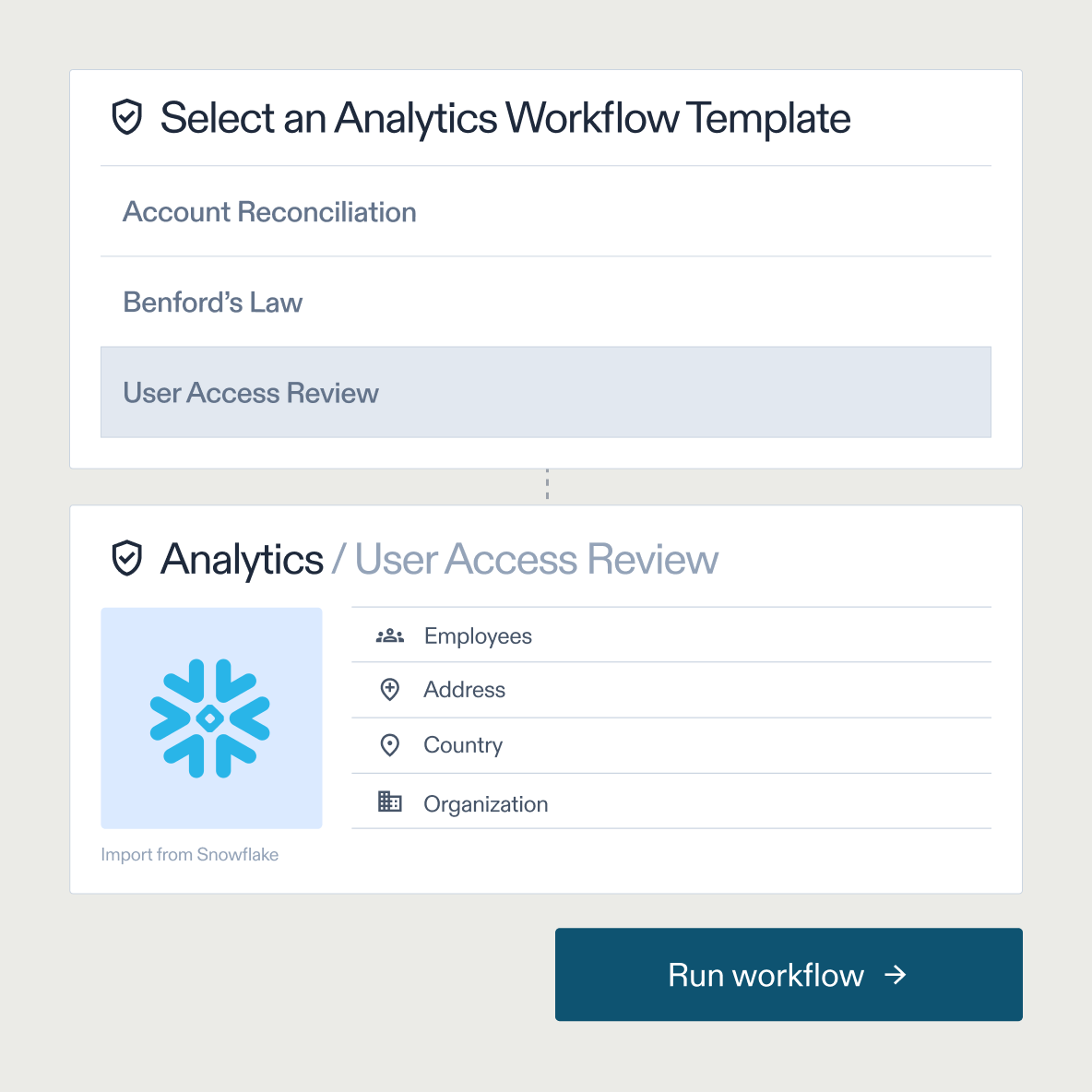
June 20, 2025 • 23 min read
HR audit process: A practical guide to streamline compliance and risk
Human resources (HR) leaders often walk a fine line between being compliance-ready and agile in their operations. On one hand, you can make sure your organization complies with regulatory standards. On the other hand, you want to minimize disruptions while collecting evidence for the same.
HR audits can sometimes become episodic compliance exercises instead of continuous value-adding cycles, largely due to reactive processes, fragmented documentation, and blind spots from previous audit practices.
If you need to turn this process into a continuous activity, make sure your team has the visibility and tools to do so.
In this article, we'll explain how to conduct an HR audit and show you how AuditBoard can boost team collaboration, centralize records, and quickly tackle unexpected problems.
What are HR audits?
An HR audit process is a comprehensive and systematic examination of HR policies, practices, documentation, and systems to ensure legal compliance and operational effectiveness. Unlike standard compliance checks, a thorough HR audit evaluates what exists on paper and what happens in practice.
The scope of the audit typically covers:
- Employment law compliance (labor standards, equal opportunity, privacy)
- Documentation completeness and accuracy
- HR processes and workflows
- Policy implementation effectiveness
- Risk assessment and mitigation strategies
For example, if an employee files a discrimination lawsuit, likely causes may be bad hiring practices or a lack of equality and diversity standards within the organization. An audit can identify and resolve these problems before they lead to negative outcomes, and it helps you build strategies to reduce the risk.
Who performs HR audits and when?
HR audits can be conducted by:
- Internal audit teams with HR expertise (internal audit director or GRC manager)
- HR professionals and department leaders (self-assessment)
- Cross-functional teams, including legal, compliance, and operations
- External consultants or auditors with specialized knowledge
The timing of HR audits varies based on organizational needs and risk profile:
- Scheduled audits: Many organizations conduct comprehensive HR audits annually or biannually, aligning with their broader risk management cycle.
- Triggered audits: Significant organizational changes (mergers, rapid growth), compliance incidents, or new regulatory requirements trigger special audits.
- Continuous monitoring: Leading organizations are moving toward ongoing assessment of key HR compliance areas rather than point-in-time reviews.
HR audits aim to be proactive rather than reactive, meaning they are conducted before problems arise rather than in response to these problems.
Why conduct an HR audit?
HR audits help you find any blind spots that could put your organization in serious trouble from a compliance and reputation perspective. Here are a few reasons HR, audit, and other teams spend time on this process:
Protect your organization from legal risks
As employment and related regulations keep evolving, more organizations are at risk for non-compliance. If you don't invest time in HR audits, these compliance gaps can go undetected for years, resulting in heavy penalties, lawsuits, and regulatory actions.
In 2024 alone, the U.S. Equal Employment Opportunity Commission (EEOC) recovered nearly $700 million for over 21,000 workplace discrimination victims. For example, one retailer paid $1 million in settlements due to such practices in its Bessemer, Alabama, distribution center. The retailer required job applicants to disclose family medical histories and used that information to exclude individuals with disabilities from employment.
If you conduct regular HR audits, you'll be able to catch these issues before they hamper your hiring and organizational processes and lead to lawsuits.
Build stronger operational processes
Many organizations treat compliance as a separate function from operations. They create redundant processes that waste resources while still leaving gaps in coverage. This disjointed approach creates unnecessary administrative burdens, introduces errors, and prevents the correct integration of compliance into HR processes.
For example, in 2023, the United Parcel Service (UPS) was ordered to pay $150,000 to an employee. The employee had diabetes and requested occasional breaks to check his blood sugar. It would've cost the company almost nothing to implement this, but instead, they fired the employee. It was later found that UPS violated the Americans with Disabilities Act (ADA), which led to the hefty fine. They also had to implement mandatory training and policy changes to avoid this in the future, leading to operational disruptions.
If you build compliance into your workflows, you'll be able to notice where reasonable accommodations are not being made or places where employee needs are not being met.
Preserve your organization’s reputation
Many compliance-related incidents become public almost immediately. If you’ve dealt with such issues in the past, regulatory authorities and potential employees may put you under more scrutiny in the future.
Schuff Steel, a steel fabrication company, paid $500,000 for violating Title VII of the Civil Rights Act in 2023. Their management was harassing Black and Latino employees and retaliating against those who complained. They suffered severe reputational damage and had to implement company-wide anti-discriminatory policies as a part of the resolution.
When you spend time auditing your HR processes, you can improve any bottlenecks internally and externally. It also shows your commitment to ethical employment practices and builds employee trust through fair treatment. In the long run, it'll also give you a competitive edge in recruitment and employee retention.
When are HR audits launched?
There are several instances when HR audits are triggered internally, for example:
- Regulatory changes: As new or updated laws affecting employment practices come into force, you must conduct an audit for compliance. In 2024 and 2025, some examples include AI legislation and pay transparency acts.
- Organizational restructuring: Whether your company is going through mergers, acquisitions, downsizing, or rapid growth, you need to reevaluate your HR processes. Such transitions usually introduce newer risks as systems, policies, or cultures change.
- Compliance incidents: When employees report issues related to discrimination, wages, or safety, you must reevaluate risks within your organization.
- Expansion or shifts in workforce model: More companies are embracing remote or hybrid work. From a legal perspective, you must ensure your organization complies with employment laws in different states or countries.
That said, when you implement robust compliance monitoring systems to evaluate these risks in real time, you won't have to wait for specific triggers in the future. All you have to do is make sure your platform of choice gives you the evidence you need and enables you to file your compliance forms.
Types of HR audits
While there are many types of HR audits, they typically fall into three categories: HR compliance audits, operational audits, and strategic audits.
1. Compliance audits
Many audit teams include a review of the organization's compliance with legal requirements, such as the Americans with Disabilities Act (ADA) or the Family and Medical Leave Act (FMLA) regulations, or internal policies. Common audits, such as I-9 file compliance, tax reporting, and salary laws, are often tested with HR audit checklists.
2. Operational audits
HR operations include auditing daily processes like compensation and employee benefits administration, performance evaluations, and safety practices. Operational audits examine processes like:
- Workflows and approval chains
- Use of technology and its integration
- Resource allocation
- Service delivery metrics
- Cross-departmental handoffs
3. Strategic audits
Much of an organization’s strategy starts with an HR strategy. They take a forward-looking perspective to ensure HR practices support long-term business objectives.
Management objectives such as filling key positions, ensuring non-discriminatory hiring practices, developing and training the current staff, and succession planning represent key risks within every organization.
What's the difference between HR audits and HR self-assessments?
Self-assessment and formal audits both examine HR functions, but they differ in fundamental ways.
Self-assessments usually rely on HR teams evaluating their practices, often without a standardized methodology. They are limited in scope, focused only on known issues, and documented informally. They're great for taking a quick pulse of the organization, but you can't look for blind spots since your questions are biased by recent issues.
On the other hand, formal internal audits are structured audits conducted by HR/compliance teams. They’re designed to cover a wide range of areas like:
- Legal and compliance
- Recruitment and onboarding
- Employee management and development
- Compensation and benefits
- Safety systems
- Performance management
- Documentation
- Employee relations
An HR audit delivers improvements to your organization's bottom line and risk profile. You can expect to see a reduction in compliance violations, better employee retention rates, and the ability to defend your organization in legal disputes. In addition, it also turns HR into a strategic partner and makes continuous improvement a possibility since you’re regularly reviewing the benefits and drawbacks of your existing systems or workflows.
Tech tip: Platforms like AuditBoard help you centralize and track controls, documentation, and workflows related to your audit lifecycle — turning compliance into an ongoing exercise.
5 steps to conduct an HR audit
Here's how you can perform an HR audit within your organization:
Step 1: Secure stakeholder buy-in and define scope
It's best to get buy-in from leadership to have the authority and access to resources as needed. First, identify an executive sponsor and cross-functional team members from relevant departments. Explain the project's purpose by speaking their language, i.e., explaining exactly why you need to conduct this audit and how it'll help the organization achieve compliance.
After that, define the objectives of your audit, and use that to establish the project's scope as well. For example, a function-specific audit would only focus on one specific area of potential inefficiency, like payroll processes. Based on this, create a realistic timeline with checkpoints and develop a communication plan for stakeholders. You may come across challenges such as:
- Resistance from internal or HR departments
- Scope creep during the project
- Unrealistic timelines to rush the project
- Lack of access to the right resources
So, make sure you document what you need before starting the audit.
Step 2: Review legal requirements and policy documents
Compile a list of applicable regulations (federal, state, local) and review industry-specific requirements. Then, gather all relevant internal policies and procedures and map regulations to specific HR processes and controls.
If newer regulations have come into play, make sure you also have clear audit protocols for each requirement. Many organizations struggle with the following:
- Outdated knowledge of regulatory requirements
- Difficulty accessing complete policy documentation
- Inconsistent versions of policies across departments or locations
This happens because you might not have centralized repositories for storing policy documents. If you use a connected risk management platform like AuditBoard, you can avoid these issues.

Track policy documents for HR compliance. Source: AuditBoard. 2025.
Step 3: Assess key HR processes and controls
Focus your assessment on high-risk areas, including:
- Hiring and onboarding processes
- Performance management
- Compensation practices
- Benefits administration
- Training records
- Employee relations
- Termination procedures
- Record keeping
- Time and attendance
- Remote work policies
To get a complete picture, use multiple assessment methods, such as document sampling, process walk-throughs, and employee interviews.
For example, you might notice that employee records state they have the necessary safety certifications, but they're all due for renewal. This means the records were not updated or no one had a system to remind the necessary stakeholders about renewing them.
Step 4: Document findings, prioritize remediation, and provide policy training
Start by categorizing findings by risk level and area. Document specific compliance gaps with supporting evidence and identify root causes rather than symptoms.
For example, if you find out that an employee filed a wage dispute, try to understand why that happened in the first place. Was it because their timesheets weren't recorded properly? Or did the approval get stuck between teams?
Develop realistic remediation initiatives with assigned owners and timelines based on your findings. You can create training to tackle these challenges and establish monitoring mechanisms to prevent such issues from happening again.
That said, don’t try to solve all your problems at once. A good remediation plan would focus on the highest-risk items first. If you notice specific risks that could amount to huge fines or organization-wide disruption, address those first. The point is that this is an ongoing activity, so treat it as such.
Step 5: Build a follow-up plan with compliance tracking and key audit metrics
Creating a follow-up plan helps you transition from a point-in-time assessment to ongoing compliance management. Ideally, you should conduct regular status checks for different compliance items and report on HR metrics of your choice.
If you’re using a platform like AuditBoard, this process gets built into your organization’s DNA. Since we automate evidence collection and surface flagged risks based on configured controls, findings, or user-defined assessments, you can more easily stay on top of potential issues with daily checks. In addition to this, you can also report on other metrics like:
- Incident response times
- Employee feedback on training/policy
- Training completion rates
These metrics will show you how well your remediation process works — and iterate on it as needed.
How does AuditBoard improve the HR audit process?
Here are a few ways in which you can automate and improve the HR audit process:
1. Centralize your documentation and evidence version control
AuditBoard creates a single source of truth for all compliance-related materials. The platform maintains all policies, procedures, and supporting documentation in one secure environment.
Plus, you can access documents with robust version control that tracks document history and changes over time. This way, you can access the necessary documents to stay compliant and see what’s changed since you last visited them.
You can also see real-time updates and automatically push policy changes to affected stakeholders.
“What AuditBoard allowed us to do is bring everything into one place. We now have a system not only from a control documentation standpoint that documents what our controls are, who our control owners are, who the exec owner is, but also tracking that through to issues — they become significantly easier now, the way we manage it. ” (Jonathon Hawes, Head of Internal Controls, IVC Evidensia)
2. Collaborate with teams like HR, legal, and risk departments
If your current compliance audits sit between different teams and you have limited ways to communicate and gather all the necessary information, AuditBoard solves that. We offer role-based access that gives the proper permissions to the right stakeholders, ensuring no one has access to files they don't need.
To make sure that compliance doesn't get lost in departmental handoffs, here are a few other ways we can help you:
- Shared dashboards provide consistent views of compliance status to all stakeholders.
- Built-in comment and discussion tools enable communication about specific compliance issues within the platform.
- Task assignment and progress tracking features make sure nothing falls through the cracks.
3. Configure your workflows to align with HR compliance requirements
You can also create customizable templates to configure audit workflows to match your specific processes. Regulatory framework mapping aligns audit activities with specific laws and regulations, while risk-based prioritization helps you focus efforts on the highest-risk areas first.
Scalable processes let you adjust depth and frequency based on risk profile. If you automate testing schedules, compliance checks become routine requirements over time.

Configure your own workflows for HR compliance. Source: AuditBoard. 2025.
This flexibility lets you right-size the audit processes based on your immediate needs and caters to your short-term objectives.
4. Remediate issues quickly using real-time dashboards and issue tracking
You can maintain all findings in one system with clear ownership using centralized issue tracking. Automated notifications also alert stakeholders about approaching deadlines.
Since it’s all automated with “always-on” monitoring, you also have all the data to conduct root cause analysis and identify problematic patterns during audits. As a result, you can improve your action plan and make better decisions after the audit.
"The internal audit group needs to be accountable to our business goals. My team and I are committed to actively following up on our recommendations and findings. If there's something that has to be done, it won't get lost in a spreadsheet or an email. Even more, records of the information are kept, which also helps with historical knowledge." (Lisa Hughes, Internal Audit Manager at TriNet)
Turn your HR auditing process into an always-on exercise with AuditBoard
HR leaders no longer need to choose between compliance readiness and operational agility. When you switch your processes to “always-on compliance,” you can identify blind spots before they become a problem for your organization.
With Auditboard, you can do all of that and more. Instead of running annual compliance checks that only capture snapshots in time, you can now maintain continuous oversight over all your HR processes.
AuditBoard helps you achieve these outcomes by centralizing your documentation, automating routine compliance workflows, and providing real-time visibility into potential issues before they escalate. This means you can focus on improving employee experiences and get ahead of inefficiencies before they happen.
Request a demo with us today if you want to standardize your HR audit process through streamlined workflows and automation documentation.
You may also like to read


Master your audit playbook: essential steps for internal audit teams

Top security audit software — cut fatigue & streamline workflows

Top headlines that defined 2025 for internal auditors

Master your audit playbook: essential steps for internal audit teams

Top security audit software — cut fatigue & streamline workflows
Discover why industry leaders choose AuditBoard
SCHEDULE A DEMO



